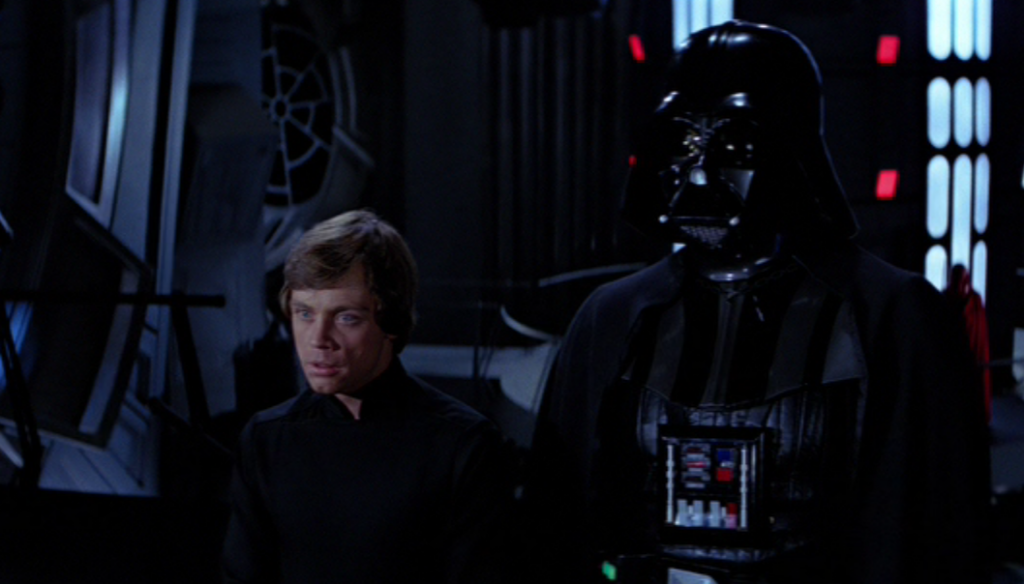
Today, Return of the Jedi turns 30 years young, and while often regarded as the Star Wars Trilogy’s weakest chapter, its strengths are manifold. Before Lucas’ effects diddling in later editions, Jedi finally gave a glimpse of Han Solo’s nemesis, the odious Jabba the Hutt. Beyond continuing the series impressive effects work in a harrowing space battle above the moon of Endor, Jedi offered redemption for Lando Calrissian and his betrayal while cementing the spiritual resurrection of Anakin Skywalker. Jedi also balanced what was marked change in tone between Star Wars and the much darker The Empire Strikes Back, returning to the serialized whimsy of 1977 while putting the diabolical Emperor Palpatine front and center and closing out Vader’s character arc.
Much of Jedi’s successful balancing act is owed to John Williams’ fantastic score, which remains the composer’s best score to date. The score’s additions of “Luke and Leia” and “March of the Ewoks” added levity and playfulness to the dour notes of his work in Empire. Drawing from two films’ worth of established motives, Williams embellishes Jedi with the franchise’s rich musical history while continuing to pump out iconic themes, all at a quality that he hasn’t matched since. As proof, here are several highlights:
“Main Titles, Approaching the Death Star”
While Jedi’s opening minutes recall visual cues from Vader’s Star Destroyer and its iconic pursuit of the Tantive IV, Williams removes the declarative motive, opting for a subdued approach that lets Industrial Light & Magic’s still impressive effects raise the intrigue and spectacle. As the Shuttle Tydirium lands, the only true call back Williams allows are “Imperial March” bookends of Vader’s entrance and exit as he precedes Moff Jerjerrod’s inevitable scolding with weeping strings. Williams plays with the theme in the woodwinds, and when it returns to the brass, it’s slowed to a trudging pace. In the hangar of the nearly completed second Death Star, we’re smack dab in the heart of the Galactic Empire.
“Den of the Rancor”
In Jedi’s original theatrical cut, the mystery of what exactly sleeps under Jabba’s Palace is preserved until Luke (and an unlucky Gamorrean Guard) plummet into its recesses. As Jabba’s riff raff look on, the Rancor emerges in a sequence reminiscent of effects guru Ray Harryhausen, in large part due to Phil Tippett’s exceptional puppet work. In the score, Williams jostles us awake with shrill percussive bursts from the xylophone and bells. The Rancor makes lunch out of the Gamorrean, but Williams enlivens Luke’s attack-and-retreat offense with a brassy, knockdown-dragout staccato. Irvin Kershner distanced Empire’s story from the Flash Gordon-inspired elements of Lucas’ vision, but Return of the Jedi returns to that old serialized style and in peak form.
“The Pit of Carkoon & Sail Barge Assault”
Lucas (in)famously added tentacles and a beak to the Sarlacc in 1997’s “Special Edition” re-releases, but his insistence on improving the monster’s fearsomeness distracts from how well Jabba’s would-be execution establishes our heroes. Williams is most famous for crafting classic themes, but his additions to Luke Skywalker’s escape plan is a master class in deconstructing an action scene and its players, from R2-D2 rolling into position to Lando’s knowing nod and Han’s half-blind cluelessness; all are moments introduced with harsh brassy bumps. The score swells as Luke salutes the droid, and we’re reminded how far these characters have come. Williams draws from the “Main Title” theme, as Skywalker somersaults to safety and his brilliant green lightsaber snaps awake. Luke’s running the show now, a far cry from the whiny farmboy we first met two movies ago.
http://www.youtube.com/watch?v=UvUtXFg65Cs#t=1m06s
“The Emperor Arrives, The Death of Yoda”
Apart from a grainy blue glimpse in Empire, the Emperor had remained a shadowy presence before 1983, brooding over all in his infinite malevolence, yet never seen in the flesh. When Palpatine finally arrives to personally oversee his new battle station’s completion, the “Imperial March” returns but Williams uses it sparingly, garnishing the pomp and fanfare of hundreds of officers and stormtroopers that have gathered before the music scatters away. The Emperor’s descent down the shuttle ramp is met with a low male chorus that feels darker than mere “brooding.” It’s a low death rattle, as if Palpatine had expired on a throne of evil while sacrificing a baby nerf to the Dark Side — maybe not that evil. Slowing the Empire’s jingle to trudging molasses is a wonderful fakeout, and like so many of Jedi’s moments, Williams takes the unexpected, quieter route.
“The Death of Yoda” is met with similar humility. First teasing “Yoda’s Theme” and the discomforting bell/harp combo from Luke’s Dagobah training, Williams juggles sentimentality with story progression. As Luke tells R2, returning to the swamp planet means keeping a promise to an old friend and Yoda’s confirmation of Vader’s true identity is met with a zen-like understanding. As Yoda expires, he lays out the remainder of Luke’s journey before him. A single French horn echoes the Jedi Master’s theme one final time before a somber digression into the “Force theme.” Like Palpatine’s arrival, it would have been easy for Williams to play the death of the 900 year old hermit as operatic but the swelling strings make for a richer farewell. On the surface, it’s only a damn puppet, but boy do we feel it.
“The Battle of Endor II”
The Rebel assault on the Imperial shield generator is broken into three parts on the film’s score, however Williams’ strongest moments occur in “Part II,” as it contains the bulk of Vader and Luke’s final confrontation. Vader’s threat to turn Leia to the Dark Side feels a bit overdone, but as this particular YouTube user shows, the moment is cinematic in spite of cumbersome Lucasian dialogue. The weight of the galaxy seems to buckle with a soaring vocal track and crying strings, as the return of the Emperor’s theme (and cackles of course), warn us that young Skywalker is straying dangerously close to the dark side. Similarly, as Palpatine’s electric bursts increase, Williams builds to a deliciously diabolical swell and repeats the Emperor’s once glacial theme with heightened shrillness. The wails of the chorus vocalize Vader’s inner struggle in a way that the addition of any dialogue would only ruin. These climactic moments are already strong because the series has taken three movies to earn them, but Williams shoots this into the stratosphere for a result that’s not just the best in Jedi but among the strongest moments in all of Star Wars.
“Victory Celebration”
Jedi’s original ending theme, which older fans have lovingly referred to as “Yub Nub,” would make for a fine conclusion to Jedi if it were but a single contained story. But Darth Vader’s funeral pyre and the Rebel fireworks cry out that this is the end of an era, and “Yub Nub,” while charmingly kitschy in its use of tribal Ewok chants, never quite does the moment justice. One of the “Special Editions” only sensible changes features Williams redoing himself with a brand new ending theme. “Victory Celebration” maintains the original tribal feel with an exotic backbeat, but Williams adds layers and complexity, this time replacing underproduced shouts with a soaring choir that crests to a celestial peak. As distracting as the new CGI additions are, this “new” ending feels more emotive and in keeping with the fun that Jedi successfully returned to the Trilogy.

